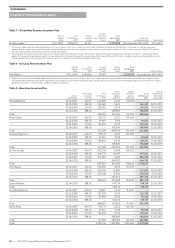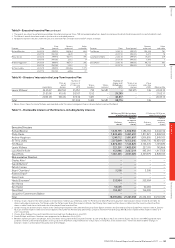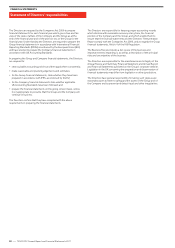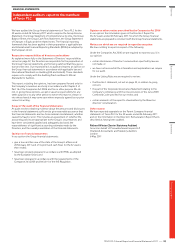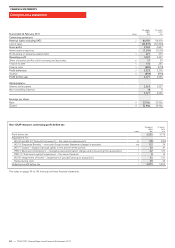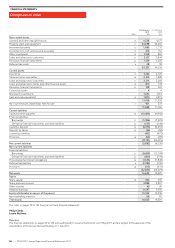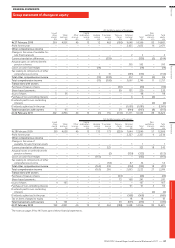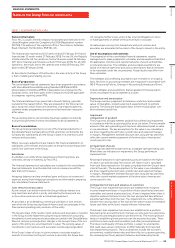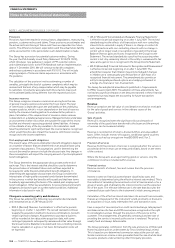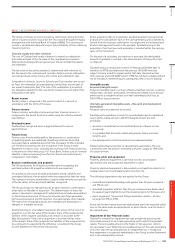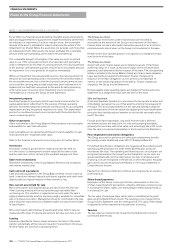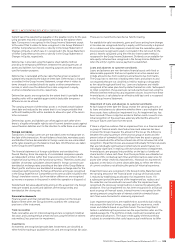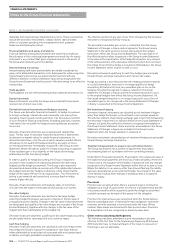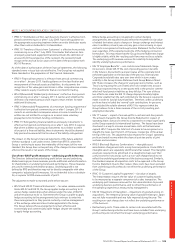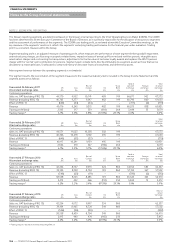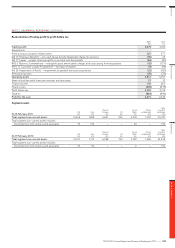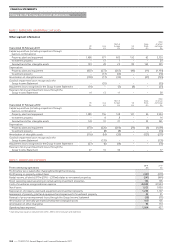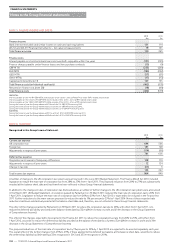Tesco 2011 Annual Report Download - page 104
Download and view the complete annual report
Please find page 104 of the 2011 Tesco annual report below. You can navigate through the pages in the report by either clicking on the pages listed below, or by using the keyword search tool below to find specific information within the annual report.
Provisions
Provisions have been made for onerous leases, dilapidations, restructuring,
pensions, customer redress and claims. These provisions are estimates and
the actual costs and timing of future cash flows are dependent on future
events. The difference between expectations and the actual future liability
will be accounted for in the period when such determination is made.
The Group has a provision for potential customer redress. During
the year, the FSA formally issued Policy Statement 10/12 (PS 10/12),
which introduces new guidance in respect of PPI customer redress
and evidential provisions to the FSA Handbook with an implementation
date of 1 December 2010. We will continue to handle complaints
and redress customers in accordance with PS 10/12. This will include
ongoing analysis of historical claims experience in accordance with
the guidance.
The calculation of this provision involves estimating a number of
variables, principally the level of customer complaints which may be
received and the level of any compensation which may be payable
to customers. Uncertainty associated with these factors may result
in the ultimate liability being different from the reported provision.
Insurance reserves
The Group recognises insurance commission arising from the sale
of general insurance policies sold under the Tesco brand. The level
of commission is dependent upon the profitability of the underlying
insurance policies, which is in turn dependent on the level of reserves
held by the insurance trading partner to underwrite the policies in
place. Calculation of the required level of insurance claims reserves
is dependent on a detailed actuarial review. Management also undertakes
an assessment of other risks which are outside the scope of this review
but that are inherent in assessing potential claims liabilities. A change
in the estimate of any of the key variables in this calculation could
have the potential to significantly impact the reserve balance recognised
which would therefore also impact the insurance commission revenue
recognised in the income statement.
Post-employment benefit obligations
The present value of the post-employment benefit obligations depends
on a number of factors that are determined on an actuarial basis using
a number of assumptions. The assumptions used in determining the
net cost (income) for pensions include the discount rate. Any changes in
these assumptions will impact the carrying amount of post-employment
benefit obligations.
The Group determines the appropriate discount rate at the end of
each year. This is the interest rate that should be used to determine
the present value of estimated future cash outflows expected to
be required to settle the post-employment benefit obligations. In
determining the appropriate discount rate, the Group considers the
interest rates of high-quality corporate bonds that are denominated
in the currency in which the benefits will be paid and that have terms
to maturity approximating the terms of the related post-employment
benefit obligation. Other key assumptions for post-employment benefit
obligations are based in part on current market conditions. Additional
information is disclosed in note 28.
Changes in accounting policy and disclosure
The Group has adopted the following new and amended standards
and interpretations as of 28 February 2010:
• IFRS 3 (Revised) ‘Business Combinations’ is effective for periods
beginning on or after 1 July 2009. The revised standard continues
to apply the acquisition method to business combinations, but with
certain significant changes. All payments to purchase a business
will be recorded at fair value at the acquisition date, with some
contingent payments subsequently remeasured at fair value through
the Group Income Statement. Goodwill and non-controlling interests
may be calculated on a gross or net basis. All transaction costs will
be expensed.
• IAS 27 (Revised) ‘Consolidated and Separate Financial Statements’
is effective for periods beginning on or after 1 July 2009. The revised
standard requires the effects of all transactions with non-controlling
interests to be recorded in equity if there is no change in control. As
such, transactions with non-controlling interests with no change in
control will no longer result in recognition of goodwill in the Group
Balance Sheet or gains and losses recognised in the Group Income
Statement. The revised standard also specifies the accounting when
control is lost. Any remaining interest in the entity is remeasured to fair
value and a gain or loss is recognised in the Group Income Statement.
• IAS 39 (Amended) ‘Financial Instruments: Recognition and Measurement’
is effective for periods beginning on or after 1 July 2009. The
amendment requires that inflation may only be hedged if changes
in inflation are a contractually specified portion of cash flows of a
recognised financial instrument. The amendment also permits an
entity to designate purchased options as a hedging instrument in
a hedge of a financial or non-financial item.
The Group has adopted all amendments published in ‘Improvements
to IFRSs’ issued in April 2009. The adoption of these amendments has
not had any significant impact on the amounts reported in these financial
statements but may impact the accounting for future transactions
and arrangements.
Revenue
Revenue comprises the fair value of consideration received or receivable
for the sale of goods and services in the ordinary course of the
Group’s activities.
Sale of goods
Revenue is recognised when the significant risks and rewards of
ownership of the goods have transferred to the buyer and the amount
of revenue can be measured reliably.
Revenue is recorded net of returns, discounts/offers and value added
taxes. Offers include: money-off coupons, conditional spend vouchers
and offers such as buy one get one free (BOGOF) and 3 for 2.
Provision of services
Revenue from the provision of services is recognised when the service is
provided and the revenue can be measured reliably, based on the terms
of the contract.
Where the Group acts as an agent selling goods or services, only the
commission income is included within revenue.
Financial services
Revenue consists of interest, fees and income from the provision
of insurance.
Interest income on financial assets that are classified as loans and
receivables is determined using the effective interest rate method. This is
the method of calculating the amortised cost of a financial asset or for a
group of assets, and of allocating the interest income over the expected
life of the asset. The effective interest rate is the rate that discounts the
estimated future cash flows to the instrument’s initial carrying amount.
Calculation of the effective interest rate takes into account fees receivable,
that are an integral part of the instrument’s yield, premiums or discounts
on acquisition or issue, early redemption fees and transaction costs.
Fees in respect of services (such as credit card interchange, late payment
and balance transfer fees and ATM revenue) are recognised as the right
to consideration accrues through the provision of the service to the
customer. The arrangements are generally contractual and the cost of
providing the service is incurred as the service is rendered. The price is
usually fixed and always determinable.
The Group generates commission from the sale and service of Motor and
Home Insurance policies underwritten by Tesco Underwriting Limited.
This is based on pre-determined commission rates at the point of sale.
Similar commission income is also generated from the sale of white label
insurance products underwritten by other third party providers.
NOTE 1 ACCOUNTING POLICIES CONTINUED
FINANCIAL STATEMENTS
100
—
TESCO PLC Annual Report and Financial Statements 2011
Notes to the Group financial statements


